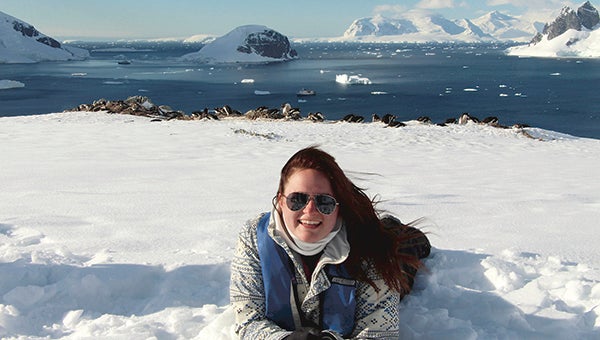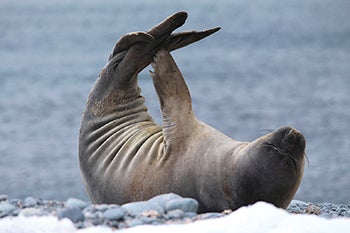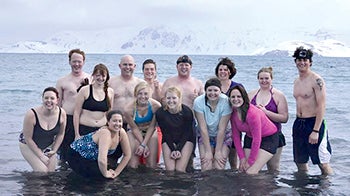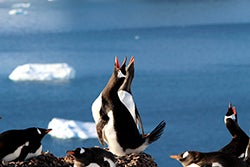A true polar plunge; Rose Creek student studies in Antarctica
Published 11:30 am Wednesday, December 24, 2014

Laura Meany sits in the snow in Antarctica during her two week study abroad trip. Temperatures averaged 35 degrees during the trip. — Photos provided
Laura Meany knew she wanted to travel, but she didn’t know she would get to hang out with penguins in Antarctica for two weeks.
Laura, a 19-year-old from Rose Creek, visited Antarctica through a study abroad program Dec. 4-19 through Iowa State University, where she is a sophomore.
“I’ve always loved to travel so I knew that I was going to take advantage of Iowa State’s program, but I just didn’t know where I was going to go,” Laura said.
Meany originally applied to travel to warmer climates in Africa, but she wasn’t accepted, and then an Antarctica trip caught her eye. She turned in a $10 application and essay explaining how it would help with her agricultural studies major. She was accepted and had no second thoughts about going.
“I was quick to accept,” she said. “I’ve never been so excited to accept something like that.”
A beautiful continent
To prepare for the trip, the 12 students and two professors spent one class each week during the semester learning about an aspect of Antarctica; whether it was a mammal or bird, the geography, or the first people to travel around the continent. Laura studied the minke whale.

This seal was one of many mammals Laura Meany saw during her two week study abroad trip to Antarctica.
“For four months I studied this whale so I was really knowledgeable on it, so if we encountered it while we were down there I would be able to talk about it,” Laura said. “Each one of us was an expert in one area.”
Unfortunately, the group didn’t see the minke whale, but they did encounter a pod of 15 humpback whales, icebergs, a leopard seal, and some of the many species of penguins.
“I learned that they’re not as cute as you think they are,” Laura laughed.
The group was excited to see the first penguin. Laura told of them spotting a penguin on an iceberg, which caused everyone on the boat to run outside to snap pictures. But the sight soon became commonplace.
“By the end of the trip we were like, ‘It’s another penguin,’” Laura joked.
The penguins weren’t the only thing that didn’t line up with Laura’s expectations.
“I always envisioned Antarctica being ice shelfs before I went — just lots of ice — and when I went down there I was so surprised to see how many mountains and fresh snow there was and how beautiful this continent was,” she said.
The average temperature during the trip was about 35 degrees, but the group also saw highs of 42 degrees and lows of negative 15 windchill.

Meany (bottom right pink shirt) and her group from Iowa State swim at Deception Island in Antarctica during Laura’s two week study abroad trip. The water at the edge was about 80 degrees, but in the middle it was ice cold. Temperatures averaged 35 degrees during the trip.
“It was pretty variant, but at the same time it’s not too different from a Minnesota winter,” Laura said.
The group learned about the value of Antarctica to the world’s eco system; how important krill is for animals to eat, how sea ice effects land and animal populations, about the hole in the atmosphere, and more.
“People forget about Antarctica,” Laura said. “It’s just kind of in the back of your mind and you never realize it, but I think they really wanted us to hit home how important it is and how it effects us here in Minnesota, not just when we were on the trip.”
The group could only stay on land for three hours at a time, due to the ever changing weather, which could make it difficult to get back to the main boat. One of Laura’s most memorable adventures was swimming at Deception Island. The island is actually a live volcano and has steam vents along the end of one of the shores.
“My whole group took the polar plunge, per say, and it’s the true polar plunge,” Laura said.
People would dive into the middle of the water, which was ice cold, and then swim to the surrounding water, which warmed to about 80 degrees.
“When you think about it, it’s a once in a lifetime opportunity; you might as well do it,” she said.

Laura Meany and her group from Iowa State saw some of the over 300,000 types of penguins during her two week study abroad trip to Antarctica.
After the two weeks, Laura was surprised to find how attached she grew to the continent. But it wasn’t just the icebergs and animals she didn’t want to leave. There were 84 passengers on the research boat they stayed on, from all over the world. After spending two weeks on a boat with the same people, saying goodbye wasn’t easy.
“I really got to know a lot of passengers on the boat,” Laura said. “So it was really cool because not only did I learn about Antarctica, experience that, but I got to learn so much about cultures from all over the world and so that was a really neat opportunity.”
Laura’s only real hesitation for the trip came because of motion sickness. Although she prepared with medication beforehand, the Drake Passage — which is where the Atlantic and Pacific and South Oceans converge — was at its worst.
“Myself along with most of the boat got really motion sick,” she said.
But that didn’t deter her, and the rocking boat even became a staple for her; its disappearance when she returned home made it more difficult to fall asleep than she thought.
‘The best two weeks of my life’
Laura had no Internet or phone access during the trip, which she described as peaceful. However, that meant she couldn’t communicate with her family during the trip.
However, Laura’s mother, Lyn Meany, has gotten used to that and her children traveling, as her eldest daughter has also traveled. In fact, Lyn encouraged her three daughters to be different and go where they want.
“I’ve always encouraged them to fly their wings, and if there’s an opportunity that comes up they should grab it and enjoy it,” Lyn said.
The Meanys put that support into action.
Overall, the trip cost about $10,000. Laura received a few scholarships from her school, but the cost was covered mostly by Laura and her parents, who split the cost. She was thankful for her family’s support.
“I’m really grateful that my family has really helped me with this opportunity, because without them I wouldn’t have been able to go,” she said.
Although Lyn didn’t expect Laura to go to Antarctica, she wasn’t surprised when Laura wanted to travel.
“She has huge goals and ambition, and it didn’t surprise me that she wanted to go there,” Lyn said. “And where she goes sky’s the limit. She’s got the drive to accomplish what she wants when she finds it.”
Laura plans to go into policy making with agriculture, but her views have broadened after the trip.
“This trip has really sparked an interest on other forms of agriculture, not just crops or animals, but natural life,” she said.
She was glad to gain a wider knowledge base to help remember there is more out there than what she might encounter.
Laura hopes to continue traveling and wants to touch all seven continents. She hopes to return to Antarctica, knowing that it would be considerably different due to the ever-changing landscapes and the weather forcing different landing sites for the boat.
“It’s easily the best two weeks of my life,” Laura said. “And I think that anyone who has the opportunity to go to Antarctica, or even thinking about it, to not hesitate on it because it’s so hard to explain unless you encounter it yourself.”





